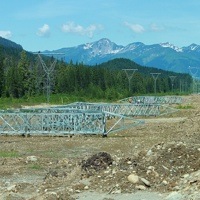Bringing reliable power to northern BC

1 of 4Guyed Y towers were flown in and erected on concrete footings along the NTL in northern B.C. — Photo courtesy of BC Hydro2 of 4The NTL required
1 of 4Guyed Y towers were flown in and erected on concrete footings along the NTL in northern B.C. — Photo courtesy of BC Hydro
BC Hydro’s 287-kilovolt Northwest Transmission Line (NTL) from Skeena substation near Terrace to the new Bob Quinn substation is currently under construction, with an expected completion date of May 2014. It will supply clean, reliable power to significant mining operations north of Terrace, including Imperial Metals’ Red Chris Mine and to the diesel-dependent community of Iskut.
Imperial Metals, in partnership with Tahltan Nation Development Corporation, is constructing the 93-kilometre Iskut extension from Bob Quinn to Tatogga Lake, which will power the mine, and is also building a 16-kilometre distribution line from Tatogga Lake that will connect Iskut to the grid. The project taps into the province’s agreement with the federal government for a $130-million federal Green Infrastructure Fund contribution to the NTL.
The line’s construction has called for some innovative construction techniques, thanks to remote and often mountainous terrain and inclement weather at higher elevations.
For instance, the original plan didn’t call for extensive use of helicopters to fly in towers and string the line, but their use became essential in maintaining the schedule, said Dave Ankrett, construction program manager for Hatch.
Hatch assisted BC Hydro in the project’s management, including cost estimating, scheduling, and contract evaluation, while providing up-to-date analysis of the project’s progress on a cost and schedule basis.
“Helicopters were used in the erection of the towers instead of mobile cranes, which would normally use the access roads,” said Ankrett. “But that’s difficult to do with heavy snowfall.”
Valard Construction partnered up with Burns & McDonnell to complete the design-build contract, including assembling and setting 1,100 steel towers and stringing 2,100 kilometres of conductor.
The guyed Y lattice towers are being installed along NTL’s right-of-way, each tower weighing approximately 9.5 tonnes and standing 27 metres high.
The Y lattice towers are assembled at a fly yard and transported by helicopter to their placement sites. Construction crews guide the towers onto pre-constructed foundations and connect each to four guy lines, which hold the tower in place.
The remote location made the logistics of pouring the tower footings on site difficult. Instead, they were precast at a plant in Terrace and hauled out to the site as needed, said Ankrett.
He adds that similar projects in Ontario or Alberta may have had to shut down for a window of time to accommodate weather that renders the ground too soft for construction vehicles; however, contractors on the NTL used rigging mats to keep the work on track.
“They act like large rafts laid out one in front of the other and equipment can drive over them, avoiding being stuck or causing sediment problems,” said Ankrett.
Dan Woznow, vice-president of energy exports for AltaGas, said the company has three run-of-river projects that will supply the NTL: Forrest Kerr, a 195-megawatt project that delivers power generated by the natural flow and elevation drop of the Iskut River; the 66-megawatt McLymont Creek project; and the Volcano Creek project with a targeted output of 16 megawatts.
From the Bob Quinn substation, AltaGas is constructing its own 40-kilometre transmission line that will feed power from the run-of-river projects, which are within 10 kilometres of each other.
AltaGas entered an agreement in 2010 with BC Hydro and the provincial government that involved a billion dollar investment and both capital and on-going contributions that will amount to around $180 million.
Forrest Kerr is one of the largest single intake run-of-river projects in North America, said Woznow. Its construction required a three-kilometre tunnel 10 metres in diameter that diverts a portion of the Iskut River.
“The tunnel leads to an underground powerhouse that is 144 metres long, 27 metres or nine storeys high, and 18 metres wide,” he said. “It will house nine generating machines.”
Including the access tunnel, the project requires over five kilometres of tunnel construction—definitely not a typical task for run-of-river projects in B.C. Both Forrest Kerr and McLymont Creek involve tunnels because of the topography.
“Most run-of-river projects in B.C. are more similar to Volcano Creek,” said Woznow, “which intake from the surface, generate electricity, and lead back to the river.”
The tunnels were constructed by Procon Mining and Tunnelling and Tahltan Nation Development. The projects have been under construction for three years and are expected to complete in 2015.
Nanaimo's F&M Installations is upgrading the Skeena substation near Terrace and constructing the new Bob Quinn substation at the north end of the NTL.



